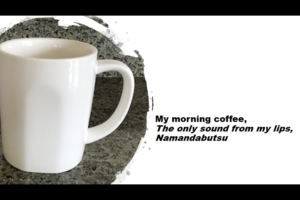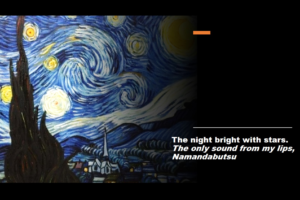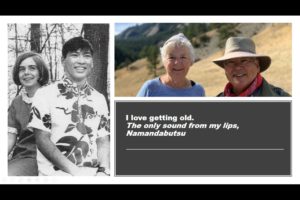A PRACTICE OF GRATITUDE FOR THE PRECIOUSNESS OF OUR LIFE AS IT IS THIS VERY MOMENT
In these times when many of us are disconnected from our normal lives, routines, and environments, we may find benefit from pausing and reflecting on the truth of our lives just as it is. In that truth, we may find our lives boring and interesting, stressful and peaceful, difficult and wonderful and everything in between. Also in that truth, we may find the things, the events and the people that make our lives so very precious. The outcome of such reflection can only be an expression of profound gratitude.
If you are looking for a means of such reflection and expression of gratitude, I offer the practice of the Nembutsu Haiku.
NEMBUTSU: For those who are not familiar with Shin Buddhism, let me share a very short explanation of the word NEMBUTSU. It is the name of the sound when we say: NAMO AMIDA BUTSU or NAMAN DA BUTSU or NAMAN DABU. The sounds are different but they all carry the same meaning. It is the name of the Buddha. In Shin Buddhism, this sound, the name, comes to our lips when we experience a profound sense of gratitude that we each have life and we have the opportunity to live it meaningfully and with purpose. Such profound gratitude often comes to us when we see an unrepeatable moment in our lives with clarity or when we see the Dharma (the Buddhist Teachings) emerging in the simple actions and events that make up our daily lives. NOTE: The Nembutsu is much more complex than what I have just shared, so I apologize to ministers and scholars. This explanation is meant for a person who has never heard of the Nembutsu.
HAIKU: This is a Japanese poetic form that consists of three lines. The first line is five syllables, the second seven syllables and the third five syllables. The number of syllables in each line for the purpose of the Nembutsu Haiku does not matter. The purpose of the Nembtsu Haiku is to capture the clarity of the moment and not adhere to the poetic form. So syllable counting is not a priority.
LEVELS OF NEMBUTSU HAIKU: There are four levels, ranging from easy to challenging.
Level One:
You write the first line of five syllables …. or more … or less.
The second and third lines are always the same (see below).
It goes like this:
Line One: You write this line.
Line Two (given): THE ONLY SOUND FROM MY LIPS (7 syllables)
Line Three (given): NAMANDABUTSU (5 syllables)
To write Line One, just look at your everyday life for the people, the events, and the images that give you pause so you can more fully experience the unrepeatable moment. This is the act of reflection on your life as it is. And Lines Two and Three combine to express your gratitude. And by the way, you should actually say NAMAN DA BUTSU out loud when you finish your haiku. For me, this practice slows down time so I can more fully experience the simple moments in my life that make it full and precious. And so I can express my gratitude. Try it.
An example of a Level 1 – Nembutsu Haiku


 THE NEMBUTSU HAIKU:
THE NEMBUTSU HAIKU:
(TO BE CONTINUED)
